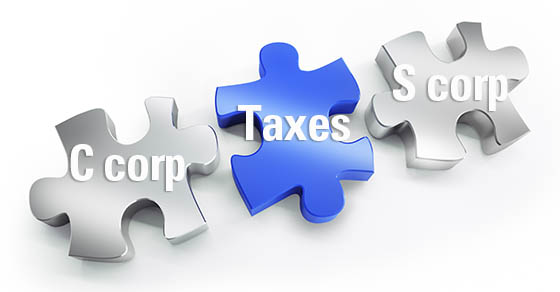Weekly Tax Brief
If your business has co-owners, you probably need a buy-sell agreement
- Details
- Published: 18 July 2024 18 July 2024

Are you buying a business that will have one or more co-owners? Or do you already own one fitting that description? If so, consider installing a buy-sell agreement. A well-drafted agreement can do these valuable things:
- Transform your business ownership interest into a more liquid asset,
- Prevent unwanted ownership changes, and
- Avoid hassles with the IRS.
Agreement basics
There are two basic types of buy-sell agreements: Cross-purchase agreements and redemption agreements (sometimes called liquidation agreements).
A cross-purchase agreement is a contract between you and the other co-owners. Under the agreement, a withdrawing co-owner’s ownership interest must be purchased by the remaining co-owners if a triggering event, such as a death or disability, occurs.
A redemption agreement is a contract between the business entity and its co-owners (including you). Under the agreement, a withdrawing co-owner’s ownership interest must be purchased by the entity if a triggering event occurs.
Triggering events
You and the other co-owners specify the triggering events you want to include in your agreement. You’ll certainly want to include obvious events like death, disability and attainment of a stated retirement age. You can also include other events that you deem appropriate, such as divorce.
Valuation and payment terms
Make sure your buy-sell agreement stipulates an acceptable method for valuing the business ownership interests. Common valuation methods include using a fixed per-share price, an appraised fair market value figure, or a formula that sets the selling price as a multiple of earnings or cash flow.
Also ensure the agreement specifies how amounts will be paid out to withdrawing co-owners or their heirs under various triggering events.
Life insurance to fund the agreement
The death of a co-owner is perhaps the most common, and catastrophic, triggering event. You can use life insurance policies to form the financial backbone of your buy-sell agreement.
In the simplest case of a cross-purchase agreement between two co-owners, each co-owner purchases a life insurance policy on the other. If one co-owner dies, the surviving co-owner collects the insurance death benefit proceeds and uses them to buy out the deceased co-owner’s interest from the estate, surviving spouse or other heir(s). The insurance death benefit proceeds are free of any federal income tax, so long as the surviving co-owner is the original purchaser of the policy on the other co-owner.
However, a seemingly simple cross-purchase arrangement between more than two co-owners can get complicated, because each co-owner must buy life insurance policies on all the other co-owners. In this scenario, you may want to use a trust or partnership to buy and maintain one policy on each co-owner. Then, if a co-owner dies, the trust or partnership collects the death benefit proceeds tax-free and distributes the cash to the remaining co-owners. They then use the money to fund their buyout obligations under the cross-purchase agreement.
To fund a redemption buy-sell agreement, the business entity itself buys policies on the lives of all co-owners and then uses the death benefit proceeds buy out deceased co-owners.
Specify in your agreement that any buyout that isn’t funded with insurance death benefit proceeds will be paid out under a multi-year installment payment arrangement. This gives you (and any remaining co-owners) some breathing room to come up with the cash needed to fulfill your buyout obligation.
Create certainty for heirs
If you’re like many business co-owners, the value of your share of the business comprises a big percentage of your estate. Having a buy-sell agreement ensures that your ownership interest can be sold by your heir(s) under terms that you approved when you set it up. Also, the price set by a properly drafted agreement establishes the value of your ownership interest for federal estate tax purposes, thus avoiding possible IRS hassles.
As a co-owner of a valuable business, having a well-drafted buy-sell agreement in place is pretty much a no-brainer. It provides financial protection to you and your heir(s) as well as to your co-owners and their heirs. The agreement also avoids hassles with the IRS over estate taxes.
Buy-sell agreements aren’t DIY projects. Contact us about setting one up.
© 2024
Be aware of the tax consequences of selling business property
- Details
- Published: 10 July 2024 10 July 2024

If you’re selling property used in your trade or business, you should understand the tax implications. There are many complex rules that can potentially apply. To simplify this discussion, let’s assume that the property you want to sell is land or depreciable property used in your business, and has been held by you for more than a year.
Note: There are different rules for property held primarily for sale to customers in the ordinary course of business, intellectual property, low-income housing, property that involves farming or livestock, and other types of property.
Basic rules
Under tax law, your gains and losses from sales of business property are netted against each other. The tax treatment is as follows:
1. If the netting of gains and losses results in a net gain, then long-term capital gain treatment results, subject to “recapture” rules discussed below. Long-term capital gain treatment is generally more favorable than ordinary income treatment.
2. If the netting of gains and losses results in a net loss, that loss is fully deductible against ordinary income. (In other words, none of the rules that limit the deductibility of capital losses apply.)
The availability of long-term capital gain treatment for business property net gain is limited by “recapture” rules. Under these rules, amounts are treated as ordinary income, rather than capital gain, because of previous ordinary loss or deduction treatment.
There’s a special recapture rule that applies only to business property. Under this rule, to the extent you’ve had a business property net loss within the previous five years, any business property net gain is treated as ordinary income instead of long-term capital gain.
Different types of property
Under the Internal Revenue Code, different provisions address different types of property. For example:
- Section 1245 property. This consists of all depreciable personal property, whether tangible or intangible, and certain depreciable real property (usually real property that performs specific functions). If you sell Section 1245 property, you must recapture your gain as ordinary income to the extent of your earlier depreciation deductions on the asset.
- Section 1250 property. In general, this consists of buildings and their structural components. If you sell Section 1250 property that’s placed in service after 1986, none of the long-term capital gain attributable to depreciation deductions will be subject to depreciation recapture. However, for most noncorporate taxpayers, the gain attributable to depreciation deductions, to the extent it doesn’t exceed business property net gain, will (as reduced by the business property recapture rule above) be taxed at a rate of no more than 28.8% (25% plus the 3.8% net investment income tax) rather than the maximum 23.8% rate (20% plus the 3.8% net investment income tax) that generally applies to long-term capital gains of noncorporate taxpayers.
Other rules apply to, respectively, Section 1250 property that you placed in service before 1987 but after 1980 and Section 1250 property that you placed in service before 1981.
As you can see, even with the simple assumptions in this article, the tax treatment of the sale of business assets can be complex. Contact us if you’d like to determine the tax implications of transactions, or if you have any additional questions.
© 2024
IRS Statement on Balance due Notices
- Details
- Published: 18 June 2024 18 June 2024
Please read the following IRS Statement on Balance due Notices:
https://www.irs.gov/newsroom/irs-statement-on-balance-due-notices-cp14
Inflation enhances the 2025 amounts for Health Savings Accounts
- Details
- Published: 06 June 2024 06 June 2024

The IRS recently released guidance providing the 2025 inflation-adjusted amounts for Health Savings Accounts (HSAs). These amounts are adjusted each year, based on inflation, and the adjustments are announced earlier in the year than other inflation-adjusted amounts, which allows employers to get ready for the next year.
Fundamentals of HSAs
An HSA is a trust created or organized exclusively for the purpose of paying the qualified medical expenses of an account beneficiary. An HSA can only be established for the benefit of an eligible individual who is covered under a high-deductible health plan (HDHP). In addition, a participant can’t be enrolled in Medicare or have other health coverage (exceptions include dental, vision, long-term care, accident and specific disease insurance).
Within specified dollar limits, an above-the-line tax deduction is allowed for an individual’s contribution to an HSA. This annual contribution limitation and the annual deductible and out-of-pocket expenses under the tax code are adjusted annually for inflation.
Inflation adjustments for 2025
In Revenue Procedure 2024-25, the IRS released the 2025 inflation-adjusted figures for contributions to HSAs, which are as follows:
Annual contribution limits. For calendar year 2025, the annual contribution limit for an individual with self-only coverage under an HDHP will be $4,300. For an individual with family coverage, the amount will be $8,550. These are up from $4,150 and $8,300, respectively, in 2024.
In addition, for both 2024 and 2025, there’s a $1,000 catch-up contribution amount for those who are age 55 or older by the end of the tax year.
High-deductible health plan limits. For calendar year 2025, an HDHP will be a health plan with an annual deductible that isn’t less than $1,650 for self-only coverage or $3,300 for family coverage (these amounts are $1,600 and $3,200 for 2024). In addition, annual out-of-pocket expenses (deductibles, co-payments and other amounts, but not premiums) won’t be able to exceed $8,300 for self-only coverage or $16,600 for family coverage (up from $8,050 and $16,100, respectively, for 2024).
Heath Reimbursement Arrangements
The IRS also announced an inflation-adjusted amount for Health Reimbursement Arrangements (HRAs). An HRA must receive contributions from an eligible individual (employers can’t contribute). Contributions aren’t included in income, and HRA reimbursements used to pay eligible medical expenses aren’t taxed. In 2025, the maximum amount that may be made newly available for the plan year for an excepted benefit HRA will be $2,150 (up from $2,100 in 2024).
Collect the benefits
There are a variety of benefits to HSAs that employers and employees appreciate. Contributions to the accounts are made on a pre-tax basis. The money can accumulate tax-free year after year and can be withdrawn tax-free to pay for a variety of medical expenses such as doctor visits, prescriptions, chiropractic care and premiums for long-term care insurance. In addition, an HSA is “portable.” It stays with an account holder if he or she changes employers or leaves the workforce. Many employers find it to be a fringe benefit that attracts and retains employees. If you have questions about HSAs at your business, contact us.
© 2024
Should you convert your business from a C to an S corporation?
- Details
- Published: 30 May 2024 30 May 2024

Choosing the right business entity has many implications, including the amount of your tax bill. The most common business structures are sole proprietorships, partnerships, limited liability companies, C corporations and S corporations.
In some cases, a business may decide to switch from one entity type to another. Although S corporations can provide substantial tax benefits over C corporations in some circumstances, there are potentially costly tax issues that you should assess before making the decision to convert from a C corporation to an S corporation.
Here are four considerations:
1. LIFO inventories. C corporations that use last-in, first-out (LIFO) inventories must pay tax on the benefits they derived by using LIFO if they convert to S corporations. The tax can be spread over four years. This cost must be weighed against the potential tax gains from converting to S status.
2. Built-in gains tax. Although S corporations generally aren’t subject to tax, those that were formerly C corporations are taxed on built-in gains (such as appreciated property) that the C corporation has when the S election becomes effective, if those gains are recognized within five years after the conversion. This is generally unfavorable, although there are situations where the S election still can produce a better tax result despite the built-in gains tax.
3. Passive income. S corporations that were formerly C corporations are subject to a special tax. It kicks in if their passive investment income (including dividends, interest, rents, royalties, and stock sale gains) exceeds 25% of their gross receipts, and the S corporation has accumulated earnings and profits carried over from its C corporation years. If that tax is owed for three consecutive years, the corporation’s election to be an S corporation terminates. You can avoid the tax by distributing the accumulated earnings and profits, which would be taxable to shareholders. Or you might want to avoid the tax by limiting the amount of passive income.
4. Unused losses. If your C corporation has unused net operating losses, they can’t be used to offset its income as an S corporation and can’t be passed through to shareholders. If the losses can’t be carried back to an earlier C corporation year, it will be necessary to weigh the cost of giving up the losses against the tax savings expected to be generated by the switch to S status.
Other issues to explore
These are only some of the factors to consider when switching a business from C to S status. For example, shareholder-employees of S corporations can’t get all the tax-free fringe benefits that are available as a C corporation. And there may be issues for shareholders who have outstanding loans from their qualified plans. These factors must be taken into account in order to understand the implications of converting from C to S status.
If you’re interested in an entity conversion, contact us. We can explain what your options are, how they’ll affect your tax bill and some possible strategies you can use to minimize taxes.
© 2024
The tax advantages of including debt in a C corporation capital structure
- Details
- Published: 14 May 2024 14 May 2024

Let’s say you plan to use a C corporation to operate a newly acquired business or you have an existing C corporation that needs more capital. You should know that the federal tax code treats corporate debt more favorably than corporate equity. So for shareholders of closely held C corporations, it can be a tax-smart move to include in the corporation’s capital structure:
- Some third-party debt (owed to outside lenders), and/or
- Some owner debt.
Tax rate considerations
Let’s review some basics. The top individual federal income tax rate is currently 37%. The top individual federal rate on net long-term capital gains and qualified dividends is currently 20%. On top of this, higher-income individuals may also owe the 3.8% net investment income tax on all or part of their investment income, which includes capital gains, dividends and interest.
On the corporate side, the Tax Cuts and Jobs Act (TCJA) established a flat 21% federal income tax rate on taxable income recognized by C corporations.
Third-party debt
The non-tax advantage of using third-party debt financing for a C corporation acquisition or to supply additional capital is that shareholders don’t need to commit as much of their own money.
Even when shareholders can afford to cover the entire cost with their own money, tax considerations may make doing so inadvisable. That’s because a shareholder generally can’t withdraw all or part of a corporate equity investment without worrying about the threat of double taxation. This occurs when the corporation pays tax on its profits and the shareholders pay tax again when the profits are distributed as dividends.
When third-party debt is used in a corporation’s capital structure, it becomes less likely that shareholders will need to be paid taxable dividends because they’ll have less money tied up in the business. The corporate cash flow can be used to pay off the corporate debt, at which point the shareholders will own 100% of the corporation with a smaller investment on their part.
Owner debt
If your entire interest in a successful C corporation is in the form of equity, double taxation can arise if you want to withdraw some of your investment. But if you include owner debt (money you loan to the corporation) in the capital structure, you have a built-in mechanism for withdrawing that part of your investment tax-free. That’s because the loan principal repayments made to you are tax-free. Of course, you must include the interest payments in your taxable income. But the corporation will get an offsetting interest expense deduction — unless an interest expense limitation rule applies, which is unlikely for a small to medium-sized company.
An unfavorable TCJA change imposed a limit on interest deductions for affected businesses. However, for 2024, a corporation with average annual gross receipts of $30 million or less for the three previous tax years is exempt from the limit.
An example to illustrate
Let’s say you plan to use your solely owned C corporation to buy the assets of an existing business. You plan to fund the entire $5 million cost with your own money — in a $2 million contribution to the corporation’s capital (a stock investment), plus a $3 million loan to the corporation.
This capital structure allows you to recover $3 million of your investment as tax-free repayments of corporate debt principal. The interest payments allow you to receive additional cash from the corporation. The interest is taxable to you but can be deducted by the corporation, as long as the limitation explained earlier doesn’t apply.
This illustrates the potential federal income tax advantages of including debt in the capital structure of a C corporation. Contact us to explain the relevant details and project the tax savings.
© 2024
Pay attention to the tax rules if you turn a hobby into a business
- Details
- Published: 09 May 2024 09 May 2024

Many people dream of turning a hobby into a regular business. Perhaps you enjoy boating and would like to open a charter fishing business. Or maybe you’d like to turn your sewing or photography skills into an income-producing business.
You probably won’t have any tax headaches if your new business is profitable over a certain period of time. But what if the new enterprise consistently generates losses (your deductions exceed income) and you claim them on your tax return? You can generally deduct losses for expenses incurred in a bona fide business. However, the IRS may step in and say the venture is a hobby — an activity not engaged in for profit — rather than a business. Then you’ll be unable to deduct losses.
By contrast, if the new enterprise isn’t affected by the hobby loss rules, all otherwise allowable expenses are deductible, generally on Schedule C, even if they exceed income from the enterprise.
Important: Before 2018, deductible hobby expenses could be claimed as miscellaneous itemized deductions subject to a 2%-of-AGI “floor.” However, because miscellaneous deductions aren’t allowed from 2018 through 2025, deductible hobby expenses are effectively wiped out from 2018 through 2025.
How to NOT be deemed a hobby
There are two ways to avoid the hobby loss rules:
- Show a profit in at least three out of five consecutive years (two out of seven years for breeding, training, showing or racing horses).
- Run the venture in such a way as to show that you intend to turn it into a profit maker rather than a mere hobby. The IRS regs themselves say that the hobby loss rules won’t apply if the facts and circumstances show that you have a profit-making objective.
How can you prove you have a profit-making objective? You should operate the venture in a businesslike manner. The IRS and the courts will look at the following factors:
- How you run the activity,
- Your expertise in the area (and your advisors’ expertise),
- The time and effort you expend in the enterprise,
- Whether there’s an expectation that the assets used in the activity will rise in value,
- Your success in carrying on other activities,
- Your history of income or loss in the activity,
- The amount of any occasional profits earned,
- Your financial status, and
- Whether the activity involves elements of personal pleasure or recreation.
Case illustrates the issues
In one court case, partners operated a farm that bought, sold, bred and raced Standardbred horses. It didn’t qualify as an activity engaged in for profit, according to a U.S. Appeals Court. The court noted that the partnership had a substantial loss history and paid for personal expenses. Also, the taxpayers kept inaccurate records, had no business plan, earned significant income from other sources and derived personal pleasure from the activity. (Skolnick, CA 3, 3/8/23)
Contact us for more details on whether a venture of yours may be affected by the hobby loss rules, and what you should do to avoid tax problems.
© 2024
Growing your business with a new partner: Here are some tax considerations
- Details
- Published: 08 May 2024 08 May 2024

There are several financial and legal implications when adding a new partner to a partnership. Here’s an example to illustrate: You and your partners are planning to admit a new partner. The new partner will acquire a one-third interest in the partnership by making a cash contribution to the business. Assume that your basis in your partnership interests is sufficient so that the decrease in your portions of the partnership’s liabilities because of the new partner’s entry won’t reduce your basis to zero.
More complex than it seems
Although adding a new partner may appear to be simple, it’s important to plan the new person’s entry properly to avoid various tax problems. Here are two issues to consider:
1. If there’s a change in the partners’ interests in unrealized receivables and substantially appreciated inventory items, the change will be treated as a sale of those items, with the result that the current partners will recognize gain. For this purpose, unrealized receivables include not only accounts receivable, but also depreciation recapture and certain other ordinary income items. To avoid gain recognition on those items, it’s necessary that they be allocated to the current partners even after the entry of the new partner.
2. The tax code requires that the “built-in gain or loss” on assets that were held by the partnership before the new partner was admitted be allocated to the current partners and not to the entering partner. In general, “built-in gain or loss” is the difference between the fair market value and basis of the partnership property at the time the new partner is admitted.
The upshot of these rules is that the new partner must be allocated a portion of the depreciation equal to his or her share of the depreciable property, based on current fair market value. This will reduce the amount of depreciation that can be taken by the current partners. The other outcome is that the built-in gain or loss on the partnership assets must be allocated to the current partners when the partnership assets are sold. The rules that apply in this area are complex, and the partnership may have to adopt special accounting procedures to cope with the relevant requirements.
Follow your basis
When adding a partner or making other changes, a partner’s basis in his or her interest can undergo frequent adjustment. It’s important to keep proper track of your basis because it can have an impact on these areas:
- Gain or loss on the sale of your interest,
- How partnership distributions to you are taxed, and
- The maximum amount of partnership loss you can deduct.
We can help
Contact us if you’d like assistance in dealing with these issues or any other issues that may arise in connection with your partnership.
© 2024
Taxes when you sell an appreciated vacation home
- Details
- Published: 02 May 2024 02 May 2024

Vacation homes in upscale areas may be worth way more than owners paid for them. That’s great, but what about taxes? Here are three scenarios to illustrate the federal income tax issues you face when selling an appreciated vacation home.
Scenario 1: You’ve never used the home as your primary residence
In this case, the home sale gain exclusion tax break (up to $250,000 or $500,000 for a married couple) is unavailable. Your vacation home sale profit will be treated as a capital gain.
If you’ve owned the property for more than one year, the gain will be taxed at no more than the 20% maximum federal rate on long-term capital gains (LTCGs), plus the net investment income tax (NIIT), if applicable. However, the 20% rate only applies to the lesser of:
- Your net LTCG for the year, or
- The excess of your taxable income, including any net LTCG, over the applicable threshold.
For 2024, the thresholds are $518,900 for single filers, $583,750 for married joint filers and $551,350 for heads of households. If your taxable income is below the applicable threshold, the maximum federal rate on net LTCGs is 15%.
If you also owe the 3.8% NIIT, the effective federal rate on some or all of your net LTCG will be 18.8% (15% + 3.8%) or 23.8% (20% + 3.8%).
You may owe state income tax, too.
Scenario 2: You’ve rented out the vacation home
In this situation, you probably deducted depreciation for rental periods. If so, the federal rate on gain attributable to depreciation (so-called unrecaptured Section 1250 gain) can be up to 25%, assuming you’ve held the property for over one year. You may also owe the 3.8% NIIT on the unrecaptured Section 1250 gain. Any remaining gain will be taxed at the federal rates explained earlier.
Plus, if you rented out the vacation home but used it only a little for personal purposes, it has probably been classified as a rental property for federal tax purposes. If so, you may have had rental losses that couldn’t be deducted currently due to the passive activity loss (PAL) rules. You can deduct these suspended PALs when the property is sold.
Scenario 3: You used the vacation home as a principal residence for a time
In this case, you might be able to claim the tax-saving principal residence gain exclusion break. Specifically, if you owned and used the property as your principal residence for at least two years during the five-year period ending on the sale date, you probably qualify for the exclusion.
There’s another major qualification rule for the home sale gain exclusion tax break. The exclusion is generally available only when you’ve not excluded an earlier gain within the two-year period ending on the date of the later sale. In other words, you generally cannot claim the gain exclusion until two years have passed since you last used it.
Of course, if you have a really big gain from selling your vacation home, it may be too big to fully shelter with the gain exclusion — even if you qualify for the maximum $250,000/$500,000 break. Assuming you’ve owned the property for more than one year, the part of the gain that can’t be excluded will be an LTCG taxed under the rules explained earlier.
Conclusion
Taxes on vacation home sales can get complicated, and we haven’t covered all the potential issues here. However, the tax results are simple if you’ve never rented out the property and never used it as a principal residence. We can fill in the blanks in your situation and answer any questions that you may have.
© 2024
When partners pay expenses related to the business
- Details
- Published: 30 April 2024 30 April 2024

It’s not unusual for a partner to incur expenses related to the partnership’s business. This is especially likely to occur in service partnerships such as an architecture or law firm. For example, partners in service partnerships may incur entertainment expenses in developing new client relationships. They may also incur expenses for: transportation to get to and from client meetings, professional publications, continuing education and home office. What’s the tax treatment of such expenses? Here are the answers.
Reimbursable or not
As long as the expenses are the type a partner is expected to pay without reimbursement under the partnership agreement or firm policy (written or unwritten), the partner can deduct the expenses on Schedule E of Form 1040. Conversely, a partner can’t deduct expenses if the partnership would have honored a request for reimbursement.
A partner’s unreimbursed partnership business expenses should also generally be included as deductions in arriving at the partner’s net income from self-employment on Schedule SE.
For example, let’s say you’re a partner in a local architecture firm. Under the firm’s partnership agreement, partners are expected to bear the costs of soliciting potential new business except in unusual cases where attracting a large potential new client is deemed to be a firm-wide goal. In attempting to attract new clients this year, you spend $4,500 of your own money on meal expenses. You receive no reimbursement from the firm. On your Schedule E, you should report a deductible item of $2,250 (50% of $4,500). You should also include the $2,250 as a deduction in calculating your net self-employment income on Schedule SE.
So far, so good, but here’s the issue: a partner can’t deduct expenses if they could have been reimbursed by the firm. In other words, no deduction is allowed for “voluntary” out-of-pocket expenses. The best way to eliminate any doubt about the proper tax treatment of unreimbursed partnership expenses is to install a written firm policy that clearly states what will and won’t be reimbursed. That way, the partners can deduct their unreimbursed firm-related business expenses without any problems from the IRS.
Office in a partner’s home
Subject to the normal deduction limits under the home office rules, a partner can deduct expenses allocable to the regular and exclusive use of a home office for partnership business. The partner’s deductible home office expenses should be reported on Schedule E in the same fashion as other unreimbursed partnership expenses.
If a partner has a deductible home office, the Schedule E home office deduction can deliver multiple tax-saving benefits because it’s effectively deducted for both federal income tax and self-employment tax purposes.
In addition, if the partner’s deductible home office qualifies as a principal place of business, commuting mileage from the home office to partnership business temporary work locations (such as client sites) and partnership permanent work locations (such as the partnership’s official office) count as business mileage.
The principal place of business test can be passed in two ways. First, the partner can conduct most of partnership income-earning activities in the home office. Second, the partner can pass the principal place of business test if he or she:
- Uses the home office to conduct partnership administrative and management tasks and
- Doesn’t make substantial use of any other fixed location (such as the partnership’s official office) for such administrative and management tasks.
To sum up
When a partner can be reimbursed for business expenses under a partnership agreement or standard operating procedures, the partner should turn them in. Otherwise, the partner can’t deduct the expenses. On the partnership side of the deal, the business should set forth a written firm policy that clearly states what will and won’t be reimbursed, including home office expenses if applicable. This applies equally to members of LLCs that are treated as partnerships for federal tax purposes because those members count as partners under tax law.
© 2024





